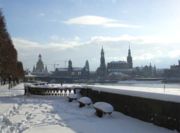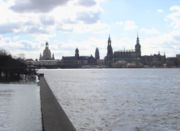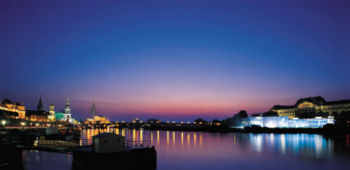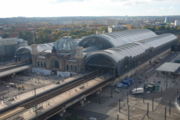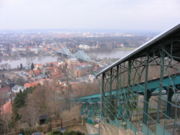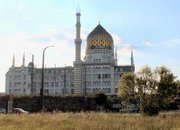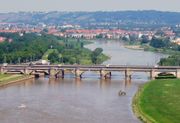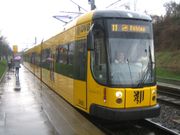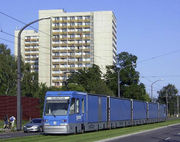Dresden
2007 Schools Wikipedia Selection. Related subjects: European Geography
| Dresden | |
|---|---|
 |
|
 |
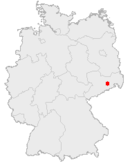 |
|
|
|
| Country | Germany |
| State | Saxony |
| Administrative region | Dresden |
| District | urban district |
| Population | 500,068 (2006) |
| Area | 328.30 km² |
| Population density | 1.523 / km² |
| Elevation | 113 m |
| Coordinates | 51°02′ N 13°44′ E |
| Postal code | 01001-01462 |
| Area code | 0351 |
| Licence plate code | DD |
| Mayor | Lutz Vogel (stand-in for Ingolf Roßberg) |
| Website | dresden.de |
Dresden ( Sorbian: Drježdźany; etymologically from Old Sorbian Drežďany, meaning people of the riverside forest) is the capital city of the German Federal Free State of Saxony. It is situated in a valley on the River Elbe. The city's population is 500,000 (2006) and the population in greater Dresden is 1.1 million. Dresden is part of the Saxon Triangle metropolitan area, with an overall population of over 3.2 million.
Dresden has a long history as the capital and royal residence for the Kings of Saxony, who for centuries furnished the city with extraordinary cultural and artistic splendor. The controversial Bombing of Dresden in World War II and 40 years of GDR changed the face of the city dramatically.
Since German re-unification, Dresden has been a cultural, political, and economic centre in the eastern part of the Federal Republic of Germany.
Geography
Location
Dresden lies on both banks of the river Elbe, mostly in the Dresden Elbe Valley Basin, with the further reaches of the eastern Ore Mountains to the south, the steep slope of the Lusatian granitic crust to the north and the Elbe Sandstone Mountains to the east at an altitude of about 113 meters. The northern parts of Dresden are in the West Lusatian highlands (Westlausiter Berg- und Hügelland). The depth influx valleys and the higher areas in the south of Dresden characterise the change to the eastern foothills of the Ore Mountains. The Elbe valley basin is a part of the Saxon Elbe Landscape. The highest point of Dresden is the Triebenberg, at about 384 meters in altitude. With a pleasant location and a mild climate on the Elbe, as well as Mediterranean architecture, Dresden was given the sobriquet "Elbflorenz" (Florence of the Elbe).
After a series of incorporation of larger country communities in the past, Dresden became the fourth largest city in area in Germany. Only Berlin, Hamburg and Cologne are larger in area.
The most important river in Dresden is the Elbe river, the only navigable body of water to flow through the city. There are also a number of tributaries such as the river Weißeritz.
Surroundings
The nearest German cities are Chemnitz (80 km to the southwest), Leipzig (100 km to the northwest) and Berlin (200 km to the north). The Czech capital Prague is about 150 km to the south; the Polish city of Wrocław is about 200 km to the east. There are some medium-sized towns such as Pirna (40,000 inhabitants), Freital (40,000), Radebeul (33,000 inhabitants) and Meißen (28,000 inhabitants) in the borough of Dresden. Riesa and Freiberg are not far away.
Greater Dresden, which spreads in the neighbouring districts of Kamenz, Meissen, Riesa-Großenhain, Sächsische Schweiz, Weißeritzkreis and in small parts in the district of Bautzen, has a population of arround 1.250.000 inhabitants.
Nature
Due to the many rural districts it has incorporated, among other things, Dresden is one of the greenest cities in Europe, with 63% of the city being green areas and forests. The Dresden Heathland ("Dresdner Heide") in the north of Dresden is a cohesive forest of 50 km² in size. There are four nature reserves in Dresden. The additional Special Areas of Conservation cover an area of 18 km². The protected gardens, parkways, parks and old graveyards host 110 natural monuments in the city. The Dresden Elbe Valley is a world heritage site which is focused on the conservation of the cultural landscape in Dresden. One important part of that landscape is the Elbe meadows which cross the city, 20 kilometre long.
Climate
Most of the city is in the Elbe valley, where the micro-climate differs from that on the slopes and in the highlands. Klotzsche, at 227 metres above sea level, is one of the higher districts of the city. Klotzsche hosts Dresden weather station. According to experience, the weather in Klotzsche is about 1° to 2° Celsius colder than the inner city's climate. The average temperature in January is -0.7° Celsius and in July 18° Celsius. Summers are hotter in Dresden and winters are colder than the German average. Dresden lies in a climate zone of cold-moderate climate crossing over to a continental climate. The inner city's average monthly temperatures are almost the same as those in cities in southwest Germany. In hot summers, Dresden is between the hot Lusatia and the milder Ore Mountains. Both regions are characterised by strong winters: temperatures of -20° Celsius are not unusual in Dresden. The driest months are February and March, with precipitation of 40 mm. Spring months have often been arid in the last couple of years (with less than 10 mm of precipitation). The most precipitation falls in July and August, at 60 mm.
Flood protection
Due to its location on the banks of the Elbe and where some water sources from the Ore Mountains flow to, flood protection is an important aspect of the city's development. Large areas are kept free of buildings to provide a floodplain. Two additional trenches of about 50 metres in width have been built to keep the inner city free of water from the Elbe river by dissipate the water downstream the inner city's gorge portion. Flood regulation systems like detention basins and water reservoirs are almost all outside the city area.
However many locations and areas have to be defended by walls and sheet pilings. A number of districts in Dresden become waterlocked if the Elbe river is flooding some of its old bayous.
City structuring
Dresden is a spacious city, not only due to the most recent incorporations in the 1990s. The districts of the city differ in their structure and appearance. Many parts of city still contain an old village core, while some quarters are almost completely preserved as rural settings. Other characteristic kinds of urban areas are the historic outskirts of the city, the former suburbs with dotted housing. In Socialist times a lot of apartment blocks were built . Not unsurprisingly, the districts in Dresden are a mix of all these kinds of area.
The original parts of the city are almost all in the districts of Altstadt (Old town) and Neustadt (New town). Growing outside the city walls, the historic outskirts were built in the 18th century. They were planned and constructed on the instruction of the Saxon monarchs, which is why the outskirts are often named after the sovereigns. From the 19th century the city only grew by incorporating other districts. Dresden was divided into the five city districts "Mitte" (centre), "Ost" (east), "West", "Süd" (south) and "Nord" (north) between 1958 and 1991.
Since 1991 Dresden has been divided into ten districts called "Ortsamtsbereich" and nine former boroughs ("Ortschaften") which have been incorporated. An "Ortsamtsbereich" hosts subunits of the Dresden community's political and administrative institutions. The "Ortschaften" are granted a higher degree of political self-rule. The district with the largest population is Blasewitz; the largest in area is Loschwitz. The largest "Ortschaft" is Schönfeld-Weißig covering an area called "Schönfelder Hochland" (Highlands of Schönfeld). The inner city includes the districts of Altstadt and Neustadt.
History
Early and pre-war history
An ancient Slavic settlement known as Drežďany (" alluvial forest dwellers") on the northern bank of the river was joined in 1206 by a German town on the southern bank, the heart of the present day Altstadt ("old town"), while the Slavic part is called Neustadt ("new town"). The founder of the city was Dietrich, Margrave of Meissen.
Since 1270, starting with Henry the Illustrious, Dresden became the capital of the margravate. After his death, however, the city became the property of the King of Bohemia and , later, the Margraves of Brandenburg. It was restored to the Wettin dynasty in about 1319. From 1485 it was the seat of the dukes of Saxony, and from 1547 the electors as well.
From 1697- 1706 and 1709- 1733 Elector Frederick Augustus I ruled from Dresden as King August the Strong of Poland; the city is also known as Drezno in Poland. Because he planned to make Dresden the most important royal residence, Augustus set out to discover the Chinese secret of porcelain (‘white gold'); under his rule, European porcelain was invented in Dresden and Meißen. He gathered many of the best architects and painters from all over Europe to Dresden; the city also experienced a vibrant blossoming of musical life at this time, particularly under the direction of Johann Adolph Hasse. His reign marked the beginning of Dresden's emergence as a leading European city for technology and art. His son Frederick August II also reigned from Dresden as Augustus III of Poland from 1734- 1763: during his reign the city was seat of a treaty that ended the Second Silesian War, and suffered heavy destructions in the Seven Years' War ( 1756-1763).
Between 1806 and 1918 the city was the capital of the Kingdom of Saxony (which was a part of the German Empire from 1871). During the Napoleonic Wars the French emperor made it his base of operation, winning here a famous battle on August 27 of that year.
During the 19th century, the city became a major center of industry, including automobile production, food processing, and the production of medical equipment. The city also developed into an important centre for the international sale of art works and antiques. The city's population quadrupled from 95,000 in 1849 to 396,000 in 1900 as a result of industrialization.
In the early 20th century Dresden was particularly well-known for its camera works, such as Ihagee and Pentacon, which produced the Praktica, and the cigarette factories, one of which was in the impressive Yenidze, a building with a multicoloured glass roof shaped like a mosque which still stands today.
The city has suffered repeated destruction: by fire in 1491, from bombardment by the Kingdom of Prussia in 1760, and during the suppression of the constitutionalist May Uprising in 1849 and the destructive Allied bombing raid of February 1945.
World War II
The city was bombed by Allied forces in the early hours of Valentine's Day, 13-14 February 1945. The Altstadt ("old town") side of the Elbe River, full of cultural treasures, was the most damaged. Because the raging fires stopped at the river, the newer Neustadt ("new town") sustained less damage and became the older side of modern-day Dresden.
To the Allies, Dresden was 22nd on the RAF's list of top 100 military/industrial targets, and had a rail network which had been virtually untouched up to that point in the war. The German forces, however, fortified the city poorly, believing it strategically unimportant. Early in the war it had been considered too distant for the Allied bombers to reach in safety, but even after it had been bombed the majority of Dresden's anti-aircraft defenses were redeployed elsewhere in Germany.
Dresden's reputation for culture is better known than its highly developed optics industry. Dresden was the home of Zeiss Ikon (which became Praktica), for example. Optics factories in Dresden produced precision aiming devices during the war. In addition many peacetime factories, such as the cigarette factories, had been converted to ammunition factories as part of the policy of " total war". These factories employed mainly local workers but also used Jewish slave labor. Some 300 Jews were kept as slave laborers at a camp in Dresden, of these the majority were killed before the war ended, along with almost all of the 6,000 Jews who lived in Dresden before the war (a famous survivor was Dresden native and writer Victor Klemperer). However these targets were not the main reason for the city being bombed. The Red Army was approaching from the East and Dresden was one of two key rail routes with marshalling yards. Although key industrial facilities were destroyed by the bombing, the main objective was to create a firestorm.
Civilian death estimates vary wildly, largely as a result of propaganda figures which received widespread publicity at the time. However the most recently available evidence from Friedrich Reichart of Dresden City Museum points to 25,000 deaths, fewer than the number that died in Hamburg. Numbers between 25,000 — 140,000 have been used in official statistics, with the Communist authorities of Dresden increasing their estimates across time; estimates in Nazi Germany by the Ministry of Propaganda varied between 350,000 and 400,000. At that time, Dresden's population was 600,000, but up to 200,000 refugees were living in cramped apartments and passing through Dresden as the Russians were now only fifty miles away. The entire inner city (15 square kilometers) was utterly devastated, and other quarters were damaged to some degree.
Many of the higher estimates are based on a discredited TB47 report, which has been visibly altered by adding a zero to the end of the totals. However the West German Federal Archive in Koblenz discovered a genuine copy of TB47. The official "Final Report and Situation (TB47)" produced by Reich Commander of the Order Police a month after the bombings. "TB47" is probably a reasonable guide to the order of casualty numbers. It states definite figures of between 18,000 and 22,000 with estimates of final numbers of 25,000 and includes the interesting sentence "Since rumors far exceed the reality, open use can be made of the actual figures."
Fortunately, much of the city's beauty has been restored, thanks to the zeal of the populace in recreating the architecture of old Dresden. Today Dresden has a strong partnership with the English city of Coventry, which was heavily damaged by German air attacks. The camaraderie is deeply supported by the populace in both cities.
Post-war period (communist rule)
After the Second World War, Dresden became a major industrial centre in socialist East Germany with a great deal of research infrastructure. Many important historic buildings were rebuilt, although the communists leaders of the city chose to reconstruct large areas of the city in a bland socialist modern style for economical and ideological reasons, namely to break away from the city's past as the royal capital of Saxony and a stronghold of the German bourgeoisie. However, some of the bombed-out ruins of churches were razed by Soviet authorities in the 1960s instead of being repaired.
Among East Germans, Dresden also earned the nickname "the valley of the clueless" because the city's location in a valley prevented its residents from watching West German TV, an illegal but popular pastime among East Germans.
On 3 October 1989, (the so-called "battle of Dresden"), a convoy of trains carrying East German refugees from Prague passed through Dresden on its way to West Germany. Local activists and residents, joined in the growing civil disobedience movement spreading across East Germany by staging demonstrations and demanding the removal of the non-democratic government.
Post-reunification
Dresden has experienced dramatic changes since the reunification of Germany in the early 1990s. The city still has many of its wounds from the bombing raids of 1945 but Dresden has undergone significant reconstruction in recent years. The most important urban renewal/reconstruction project was the reconstruction of the Frauenkirche ("Church of Our Lady") and the surrounding Neumarkt district. The church, once the city's symbol and considered the world's finest Protestant church, was rebuilt following German reunification in 1991 from the remaining pile of rubble of the original church's ruins thanks to private and corporate donations. It was completed in 2005, a year before Dresden's 800th birthday. The new Frauenkirche was rebuilt according to historical drawings and photographs and is now open to public service since Reformation Day 2005. Despite the inner city's almost total destruction in World War II, many areas in the central city have been restored to their former glory. The urban renewal process in Dresden will continue for many decades but public and government interest remains high and there are numerous large budget projects underway — both historic reconstructions and modern plans — that will continue the city's recent architectural renaissance.
In 2002, torrential rains caused the Elbe to flood 9 m, past its 1845 record height, damaging many landmarks (See 2002 European flood). The destruction from this "millennium flood" is no longer visible, due to the rapidity of reconstruction. Disaster relief for the millennial flood came from around the world.
In 2004 the United Nation's cultural organization UNESCO declared Dresden and the surrounding section of Elbe river valley to be a "World Heritage" site.
Dresden remains a major cultural centre of historical memory, owing to the city's destruction in World War II. Every year on 13 February, the anniversary of the major British fire-bombing raid that destroyed most of the city, tens of thousands of demonstrators gather to commemorate the event. Similar ceremonies held during the period of communism were specifically directed at demonizing the Western Allies, above all the United States. Since reunification, the tone of the ceremonies has taken on a more neutral and pacifist tone. In recent years, however, right-wing extremist skinheads have tried to instrumentalize the event for their own political ends. Affiliated with the radical right National Democratic Party of Germany (NPD), they cite the bombing of Dresden in order to portray Germans as the real victims of the Second World War, and try to take advantage of anti-American sentiment to do it. In 2005, Dresden was host to the largest Neo-Nazi demonstration in the post-war history of Germany. Between five and eight thousand Neo-Nazis took part, mourning what they call the Allied bomb-holocaust (German: Alliierter Bombenholocaust).
Government and politics
Municipality and city council
City council
The city council is defining the basic principles of the municipality by decrees (Stadtverordnungen) and statutes (Satzungen). Both are decisions of legislating. The council gives orders to the burgomaster by voting for resolutions (Beschlüsse) and has some kind of executive power in this way. It is elected by the citizenry for a legislature of five years by an election system of three votes per citizen. There a advisory councils for local affairs of seniors and immigrants. The ten Ortsamtsbereiche (districts) have a advisory councils which has to be heard in affairs of the district. The Ortschaften (former boroughs) still have smaller councils, which can decide even more freely in affairs of the Ortschaften.
The current city council of Dresden has 70 seats. It was elected in 2004 and constists of six political factions:
- 21 mandats of the Christian Democratic Union
- 17 mandats of the Left Party
- 9 mandats of the Alliance '90/The Greens
- 8 mandats of the Social Democratic Party of Germany
- 7 mandats of the Free Democratic Party and German Social Union
- 6 mandats of the Bürgerfraktion (Citizen Faction) (Bürgerliste, Freie Bürger, Volkssolidarität; in each case two seats)
The three mandats of the Nationale Bündnis (National Pact which is related to the far-right National Democratic Party of Germany) do not build up a faction.
There is no persistent governing majority in the city council of Dresden. Decision and majorities of the council are changing in context of the political subjects.
Burgomasters
The Supreme Burgomaster is directly elected by the citizen for a term of seven years. Executive functions are normally elected indirectly in Germany. However the Supreme Burgomaster shares a lot of executive rights with the city council. Governing majorities can be in opposition to the Supreme Burgomaster. He is the head of municipality, responsible for the city's operative affairs and ceremonial representant of the city. The highest departments of the municipality are managed by seven burgomasters. The First Burgomaster (currently the burgomaster of culture) is also the deputy to the Supreme Burgomaster.
The current Supreme Burgomaster Ingolf Roßberg was convicted in the criminal cases of infidelity and assistance of bankruptcy in first instance. He is in furlough and suspended by a higher authority. The First Burgomaster and burgomaster of culture Lutz Vogel is stand-in for him.
Municipality
The municipality is divided into seven departments and the Mayor's Office.
- The department of general administration is responsible for the municipality's personal, information technology and for the administration of the schools in the city.
- The department of finance and real estates is responsible for the city treasury. The city agencies of real estates, taxes and civil engineering as well as the central bureau of placing are responsible to that department.
- The department of public order and security is responsible for fire and civil protection, food control and for the hospitals in the city. The city agencies of public order and law as well as the civil registry office are responsible to that department.
- The department of culture is responsible for the municipal museums and libraries. The agency of monument conservation is responsible to that department. A lot of the cultural institutions in Dresden are directly responsible to the Free State of Saxony as there are the state art collections and the opera house.
- The department of social affairs is responsible for the municipal kindergardens. The agencies of youth welfare, health and social welfare is responsible to that department. Social welfare is a matter of the cities and communities in Germany.
- The department of urban development is responsible for mobility and central technical services. The agency of city development, construction inspection, land surveying and streets and excavation are responsible to that department.
- The department of economy is responsible for the wastewater and the cemeteries. The agencies of business development, green spaces and wasting as well as the environmental agency are responsible to that department.
The City of Dresden owns a lot of institutions and enterprises. Some of them are private companies (for example the Dresdner Verkehrsbetriebe (Transport authorities), the DREWAG (public services and energy supply), the Messe Dresden (fair ground) or the Zoo Dresden (which is a non-profit GmbH). The city's company of apartment estates was sold under intensive attention to the us-american Fortress Investment Group.
Local affairs
The subjects of local affairs in Dresden are often about the urban development of the city. Esspecially architecture and design of public places is often controversial discussed. The reconstruction of completely destroyed buildings around the Frauenkirche at the Neumarkt square is aslike the completely moderne Wiener Platz square in front of the Hauptbahnhof train station critised. The discussion of the Waldschlößchenbrücke, which is a planned bridge crossing the Elbe river, reached an international attention due to it is crossing the Dresden Elbe Valley World Heritage Site. Supporter of the bridge are hazarding the consequences of losing the status of World Heritage to get the construction started.
Dresden sold its company of apartment housings to the Fortress Investment Group. The city gained some 982 Million Euro and paid off almost all of its loans. On the one side Dresden became the first german city free of dept, on the other side Dresden lost all of its control on the subsidized housing market. The risks in long term were even in nationwide media discussed as well as chances of such solds were surveyed in other cities.
Other topics pertaining to the funding and expanding of cultural institutions. The construction of a new stadium is planned for years but not realised yet. Start of the upgrading of the Rudolf-Harbig-Stadion is in spring 2007 soonest.
Sister cities
Along with its twin city Coventry, Dresden was one of the first cities to twin with a foreign city. The two cities became twins after World War II in an act of reconciliation as both had been nearly destroyed by bombing during the war.
 Coventry, United Kingdom, since 1959
Coventry, United Kingdom, since 1959 Saint Petersburg, Russia, since 1961
Saint Petersburg, Russia, since 1961 Wrocław, Poland, since 1963
Wrocław, Poland, since 1963 Skopje, FYR Macedonia, since 1967
Skopje, FYR Macedonia, since 1967 Ostrava, Czech Republic, since 1971
Ostrava, Czech Republic, since 1971 Brazzaville, Congo, since 1975
Brazzaville, Congo, since 1975 Florence, Italy, since 1978
Florence, Italy, since 1978 Hamburg, Germany, since 1987
Hamburg, Germany, since 1987 Rotterdam, Netherlands, since 1988
Rotterdam, Netherlands, since 1988 Strasbourg, France, since 1990
Strasbourg, France, since 1990 Salzburg, Austria, since 1991
Salzburg, Austria, since 1991 Columbus, Ohio, USA, since 1992
Columbus, Ohio, USA, since 1992
Coat of arms
Blazon: Party per pale on a golden shield showing a black lion to dexter and two black pales to sinister. The lion is looking to dexter and has a red tongue. The city's colours are derivatively black and yellow ( Or).
Meaning: The lion was representing the Margraviate of Meissen and the pales called the Landsberger Pfähle were representing the Mark Landsberg both ruling the city of Dresden. Since 1309 both coat of arms in combination are verifiably in use. The pales were originally blue but converted to black to differentiate from the two other important Saxon cities of Leipzig and Chemnitz having very similar coat of arms.
Culture and architecture
Dresden is attempting to take up its old cultural importance among the European cities that it had from the 19th century to the 1920s when it was a centre of fine and visual arts, of architecture and music. In that era famous artists like Ernst Ludwig Kirchner, Otto Dix, Oskar Kokoschka, Richard Strauss and Gret Palucca were active in the city. Dresden is home to several precious art collections, world-famous musical ensembles and important buildings of many eras. Dresden is also a location of festivals. Culture is often to be found interacting with technology in many art collections and examples of architecture.
Theatre
The Saxon State Opera is the most important theatre institution in Dresden. It is descended from the opera group of the old Saxon electors. Its first own opera house, the first Semperoper, was opened in 1842. In particular, many operas by Richard Strauss had their premiere at the Saxon State Opera. The performances of the opera are often sold out months in advance.
The State Theatre Dresden runs a number of smaller theatres. The theatre at the Zwinger is the largest theatre of dramatic art in Dresden. Still next to the Zwinger Palace, the theatre in Dresden castle is even smaller.
The Dresden State Operetta is the only independent operetta in Germany. Due to the destruction of the inner city in 1945, it was built in Leuben in the outskirts of Dresden, in a rural hotel. It is not owned by the Free State (as the name of the ensemble suggests) but the city. Today the city council is trying to move the Operetta to a planned building next to the main train station.
Other theatres are:
- The Herkuleskeule ( Hercules' club), an important site in the German-speaking political cabaret
- The Theatre der Jungen Generation (Theatre of the Young Generation), running modern interpretations of plays in the context of present social problems and issues
- Many small theatres like "Das Societätstheater" or "die Bühne" are run by private cultural societies
Musical ensembles
The " Sächsische Staatskapelle Dresden" is the orchestra of the Saxon State Opera and was founded in 1548. It is one of the oldest orchestras and is known as Strauss-Orchestra. Nevertheless the musical ensemble was also moulded by Carl Maria von Weber and Richard Wagner conducting the orchestra.
The Kreuzchor (Choir of The Cross) is a boy's choir. It consists of pupils of the Kreuzschule, which is a grammar school today; the Kreuzchor is the choir of the Kreuzkirche. Choir, church and school were first mentioned in the 13th century and are as old as the city of Dresden. The "Dresdner Kapellknaben" (which are not related to the Staatskapelle) are the choir of the Catholic cathedral.
The Dresden Philharmonic Orchestra is the orchestra of the city of Dresden. It was founded in 1870, called the Gewerbehausorchestra, and renamed in 1915.
The Dresdner Sinfoniker are a symphony orchestra and newcomers to the international musical ensembles in Dresden. The orchestra was founded in 1996 and became famous for its crossover of classic and modern music and for its cooperation with the Pet Shop Boys dubbing The Battleship Potemkin film and releasing the album of that name.
Museums, presentations and collections
Dresden hosts the Staatlichen Kunstsammlungen Dresden (Dresden State Art Collections) which is one of the world's most important museums and collections. The art collections consist of eleven museums of which the Gemäldegalerie Alte Meister and the Grünes Gewölbe are the best known. The art collection is owned by the Free State of Saxony and mostly uses the Zwinger Palace and Dresden Castle. Some of the museums, such as the Mathematisch-Physikalischer Salon, exhibit art within the context of technology, such as precious globes, measuring equipment and chronographs which are artistically formed and perfect in function.
Other museums and collections owned by the Free State of Saxony in Dresden are:
- The Landesmuseum für Vorgeschichte (State Museum of Prehistory)
- The Staatliche Naturhistorische Sammlungen Dresden (State Collection of Natural History)
- The Museum für Völkerkunde Dresden (Museum of Ethnology)
- The "Universitätssammlung Kunst + Technik" (Collection of Art and Technology of the Dresden University of Technology)
- Verkehrsmuseum Dresden (Transport Museum)
The Deutsche Hygiene-Museum was found for mass education in hygiene, health, human biology and medicine. It stood in context of the Dresden industry of medicine and hygiene products and was founded by the industrialist Karl August Lingner, who produced Odol hygiene products. The museum's Transparent Woman, showing the organs of human beings as a see-through sculpture, became world famous. Dresden also hosts the Military Historical Museum of the Bundeswehr in the former garrison in the Albertstadt.
The former convention house of the farmer's estate (called the Landhaus) is now home of the Dresden City Museum, which exhibits a collection of historical objects and has a smaller collection of paintings. The city has some museums specialising in artists who lived in the city (for example the "Carl Maria von Weber Museum" and the Kügelgenhaus. Another museum, the Technische Sammlungen (Technical Collection) was established in the Pentacon building, the old factory where Praktika cameras were once built. The collection includes historic cameras, computing technology and entertainment technology.
Architecture
Although Dresden is often said to be a Baroque city, its architecture is influenced by more than one style. Other eras of importance are the Rennaissance and Historism as well as the contemporary styles of Modernism and Postmodernism.
Royal household
The royal buildings are among the most impressive buildings in Dresden. The Dresden castle was once the home of the royal household. The wings of the building have been renewed, built upon and restored many times. Due to this segued integration of styles, the castle is made up of elements of the Renaissance, Baroque and Classicist styles.
The Zwinger Palace is just on the other side of the road from the castle. It was built on the old stronghold of the city and was converted to a centre for the royal art collections and a place to hold festivals. Its gate (surmounted by a golden crown) by the moat is a very famous part of the building.
Another famous site is also on the former city wall: Brühl's Terrace was a gift to Heinrich, count von Brühl and became an ensemble of buildings. It was opened to the public in the 19th century; previously the whole area was closed off for the nobility. The ensemble includes the Albertinum, the Ständehaus and the Secundogenitur (home of the second son of the electors and kings).
August the Strong was very impressed by Venice with its Canale Grande and decided to model the Dresden Elbe Valley on this example using the Elbe's ample bends. Nevertheless he initiated the creation of a cultural landscape which has been a World Heritage Site since 2004 and which differs from the Canale Grande with its meadows and forested yards. This landscape hosts vineyards not far away from the inner city. The World Heritage Site passes through almost the whole city. Due to conflicts involving a modern bridge to be built across the river at a sensitive spot, the site has been added to the list of endangered World Heritage sites.
Pillnitz Castle was built as a summer residence in the style of Chinoiserie alongside the Elbe on the southern side and the slopes and vineyards on the other.
Sacral buildings
The Hofkirche was the church of the royal household. August the Strong, who wanted to became King of Poland, was forced to convert to the Catholic religion, as the Polish king had to be Catholic. At that time Dresden was strictly Protestant. August the Strong ordered the building of the Hofkirche (1739 to 1755) to establish a sign of religious importance in Dresden. The church is the cathedral "Sanctissimae Trinitatis" since 1980. The staggered facade is completed by two balustrades that are decorated width 74 statues of saints. The church hosts the crypt of the Wettin Dynasty.
The Frauenkirche was build almost contemporaneously by the citizens of Dresden between 1726 and 1743. It is said to be the greatest cupola building in Central and North Europe. Furthermore, the Frauenkirche is the largest church in Dresden, leading Dresden to be one of the few places where a cathedral is not the largest Christian sacral building. The Basilica di Santa Maria della Salute in Venice is said to be an archetype for the Frauenkirche whose cupola firstly was planned to be a timber construction. In that era of the Dresden architecture style was enormously inspired by Venice and Florence especially by the landmarks in northern Italy.
The Kreuzkirche is another main church of the Protestants and is according to the location the oldest church of Dresden. The community of the Frauenkirche, which is in fact a few years older, is a former outskirt of the city. The Kreuzkirche has often been destroyed by conflagration and wars. The preserved style of architecture is that of the baroque edition supplemented by the elements of the Art Nouveau.
Contemporary architecture
Dresden has been an important site for the development of contemporary architecture for centuries, and this trend has naturally extended into the 20th and 21st centuries.
Historicist buildings made their presence felt on the cityscape until the 1920s. One of the youngest buildings of that era is the Hygiene-Museum, which is designed in an impressively monumental style but employs plain facades and simple structures. It is often but wrongly attributed to the Bauhaus school.
The Bauhaus was, in fact, active in Dresden. It designed several public buildings of which the old part of the Saxon State Parliament is the most famous. Other modern architectural styles were built among more historical structures, especially along the razed city wall. The tower block at the Albertplatz is one of the buildings of the New Objectivity or Expressionist architecture that still exists. Garden cities and housing space collectives were developed in the 1920s and 1930s, raising the quality of life for of lower income residents.
The architectural plans of the National Socialist regime were not realised. As in Berlin, where Nazi architects planned the monumental restructuring of the city as "Germania, Capital of the World", large-scale buildings next to the Großer Garten park were meant to establish Dresden as a subsidiary, regional capital. Some of the contemporary buildings were found to be "un-German". Among them is the famous Kugelhaus (Globe House) which was torn down. Along with the older construction many modern buildings were destroyed in the Second World War.
Most of the present cityscape of Dresden was built up after 1945, a mix of reconstructed or repaired old buildings and new buildings of the modern and postmodern styles of the second half of the 20th century.
Under the German Democratic Republic, from 1945 and 1990, Dresden was planned and reconstituted as a model socialist city. Streets were arranged to keep chimneys of the industry in sight. Wide streets and squares were cut into the landscape. Central public spaces, such as the Altmarkt, were surrounded by neoclassical Socialist Realist structures of relatively high quality. Other structures were built with less sensitivity toward their historic or geographic context. (for example the housing block at Prager Straße) of industrial housing construction. Other buildings, including the the Kulturpalast or the Centrum-Warenhaus (a large department store), represent the international style. Much of the new public architecture was influenced by public outcry and protest; the Kulturpalast, for example, was first planned as monumental tower like the Warsaw Palace of Culture and Science but arranged in a flatter form in context of the historic buildings.
After 1990 and German reunification, new styles emerged. The Saxon State Parliament was under construction until 1993 and uses the old part of the former financial ministry in combination with a new wing of glass and steel in classic modern style. It represents the beginning of the so-called New Terrace (extending Bruel's Terrace). The youngest building of that ensemble alongside the river Elbe is the International Congress Centre Dresden which is a postmodern building mirroring motifs of the historic terrace and of the Elbe landscape.
The New Synagogue, at the other end of the old city, is another award-winning contemporary structure. Built almost completely of stone, its vertical edges are sloped, to reflect Jewish religious practices.
The nearby UFA-Kristallpalast cinema is a recent design by the firm Coop Himmelb(l)au. With its tall cube of class it is one of the largest deconstructivist buildings in Germany. Another deconstructivist project been planned for Dresden by Daniel Libeskind: the military history museum in the classicist Arsenal building which is currently under reconstruction. Libeskind has designed an arrow breaking through the building in the direction of the inner city, symbolising the flight formations during the bombardment of Dresden 1945- appropriate to the context of the military museum that has existed in that building since 1918.
Norman Foster is responsible for the last acts of the reconstruction of the Dresden Hauptbahnhof train station. He designed a new teflon roof using the old steel girders and a new glass cupola of the entrance hall. The large white housetop is a unique landmark that can be seen from many positions on the slopes above the Elbe valley.
The Saxon State Library was build between 1998 and 2002 on the campus of the Technische Universität Dresden. It is mainly underground, with two cuboids rising up from under it. While the walls are of other substances, glass is used extensively in the roof portion of the building. The central reading room extends two stories underground.
Technical buildings
Dresden is also known for a couple of technical buildings. Most of them were build in the second half of the 19th century and at the beginning of the 20th century. A centre of technical buildings are the Schillerplatz and the Körnerplatz. This two places are named after Friedrich Schiller and Carl Theodor Körner and are connected by the " Blue Wonder" Elbe bridge. This bridge is one of the oldest cantilever russ bridges in Germany. It is often said to be called Wonder due to the static without a pillar in the river or due to its colour, that changed from green to blue.
Nearby two mountain railways are connecting the Körnerplatz with two quarters of villas. The Standseilbahn Dresden is funicular railway overcoming a height in difference of 95 metres. It connects Loschwitz and Weißer Hirsch. The Schwebebahn Dresden is the oldest suspension railway of the world and connects Loschwitz and the upper parts of Loschwitz.
The city's building officer Hans Erlwein is the architect of a couple of industrial buildings that were build in the inner city. His storage building nearby the Semperoper is adapted to its neighbourhood by its dissected roof. Another building planned by Hans Erlwein is the slaughterhouse complex. This location became famous by the novel Slaughterhouse-Five by Kurt Vonnegut.
Also a landmark of technical buildings is the Yenidze which was build as a cigarette factory. Its architecture is enormously influenced by marketing and orientally styled to associate to the provenance of tabac products. Even the smokestacks are styled like minarets. The architecture was controversial discussed but is now under monument conservation. The building is used as a block of offices.
The Fernsehturm Dresden-Wachwitz is the TV tower of the city. It is 252 metres high and towers the valley above in 373 metres in height. There is a pumped-storage power station in the western part Niederwartha. It has a rated output of 120 MW and was build between 1927 and 1930 at a slope of the valley. The ground basin is nearby the Elbe river. The difference in altitude is about 143 metre. The capacity of energy given by the volume of the upper basin is about 560 MWh. This power station is reloading its capacity over night and produces electricity over day.
There are also a couple of water stations in the city. Most of them are using the bank filtered water of the Elbe river. One of the oldest water station is the Saloppe which is extracting fresh water from small rivers of the Dresdner Heide forest.
Bridges
The place of the Augustusbrücke between Altstadt and Neustadt in the centre of the city is the location of the oldest bridges in Dresden. A bridge at that place is already reported in the 13th century. Also reported are the plural demolitions of that bridges in floods of the past as appeared the last time yet in the march floods of 1845.
The first bridge passed by the river is the Loschwitzer Brücke (famously known as Blaues Wunder, see above). The Albertbrücke at the border of the inner city is some kilometre downstream. The following bridges Carolabrücke, Augustusbrücke and Marienbrücke are in short distances.
The Marienbrücke is divided into a road/tram bridges and a railway bridge. It connects the two train station of most importance in Dresden Hauptbahnhof and Dresden-Neustadt railway station on the historic Leipzig-Dresdner railway and is aslike the Carolabridge which hosts four lines of an important road and an extra double-track of the tram.
Sculptures, monuments and fountains
There are about 300 fountains and springs in Dresden were they are often placed in parks or on squares. The wells only serve in a decorative function since there is a fresh water system in Dresden.
The Artesian aquifer at Albertplatz is the only spring in Dresden that is run all-the-year due to its warm water. It was planned to produce fresh water for the Neustadt districts. About 3900 litre per hour are flowing upwards the 240 metre depth well naturally by pressure.
A lot of the springs in Dresden are historic monuments like the "Nymphenbad" in the Zwinger or the "Cholerabrunnen". The "Cholerabrunnen" was founded by Eugen von Gutschmid in thanks that Dresden was untroubled by the cholera epidemics in the 1940s years.
Springs and fountains are also elements in contemporary cityspaces: Modern springs are arranged along the Prager Straße. Due to their styles of fountain, they are called "blowballs". The springs alongside the Hauptbahnhof train station are above the glass ceiling of a underground parking.
The most famous sculpture in Dresden is the golden equestrian sculpture of August the Strong called the "Goldener Reiter" (Golden Cavalier) on the Neustädter Markt square. It shows August at the beginning of the Hauptstraße (Main street) on its way to Warsaw where he was King of Poland in personal union. Another sculpture is the memorial of Martin Luther in front of the Frauenkirche.
Others
- Kunsthofpassage in the Outer Neustadt
- Dresden Fair Ground in the New Slaughterhouses in the Ostragehege
- Rudolf-Harbig-Stadion and Heinz-Steyer-Stadion
- The Old Slaughterhouses
- Pfunds Molkerei
- Gasometer in Reick
Cinemas and cinematics
There still a lot of small cinemas and theatres of cinematic arts offering a programme of cult films and current films of low budget or weak promotion that were selected by their cultural worth. Dresden also has a couple of Multiplex Cinemas of which the Rundkino is the oldest. The cinema build in a circular building is today out of order.
Dresden has been a centre in the production of animated films and of the optical cinematic techniques. The Dresden Filmfest hosts a contest of short subjects which is among the most endowed contests in Europe.
Lifestyle
Dresden's heterogene cityspace is strongly influencing the lifestyle in the city. Lifestyle in Dresden can be very urban and very rural in just a short distance. Dresden hosts a lot of events and concerts.
The inner city splits its function to a couple of districts. The historic town centre serves as the most important touristic area and offers a lot of restaurants, bars and pubs that are visited by tourists as well as by inhabitants. The Seevorstadt south of the historic town centre is the most important shopping area in Dresden. It is crossed by the famous Prager Straße shopping street with large department stores and smaller shops. The tangents of the Altmarkt, which is the oldest market place in Dresden, extend this shopping area into the town centre. The Seevorstadt with the main station and an important tram hub in close distances is also a very urban area of Dresden. The Neustadt is divided into the touristic Inner Neustadt, which also offers a lot of gastronomy and retails as well as important cultural institutions, and the Outer Neustadt which is very important in the night life of Dresden. The Outer Neustadt is the centre of subcultural and youth cultural Dresden with a lot of clubs, bars, small stages and alternative culture institutions.
Also green areas of Dresden are involved in the lifestyle. The huge Parks as well as the long Elbe meadows are used at day and at night for sport, party and cultural activities. Local recreation takes place in the National Park Saxon Switzerland, in the Eastern Ore Mountains or in the flat Moritzburg lakeland which are all not far away. The cultural landscape of the Dresden Elbe Valley is a world heritage site but also part of the everyday life of many inhabitants. The landscape crosses the city and is passed through by commuter traffic, used in leisure time or hosts habitation of ten thousands of residents.
Dresden is a city of undergraduates with an own infrastructure of event locations and cultural institutions. There are 16 student clubs in the Altstadt and Südvorstadt near the Universities.
Due to the Elbe river, rowing and canoeing are leisure activities in Dresden. Dresden is a centre of chess and host city of the Chess Olympiad 2008. Night events in skating are proffered weekly in the summer period.
Habitation differs strongly in Dresden. In some cases old village cores are only a few minutes away from urban districts. The inner city is enormously displaced to the southern border of the city. The Outer Neustadt with the highest density of inhabitants is just a kilometre away from the Dresdner Heide forest in the North. The large area in the south eastern and its outskirts are the places of residence with the most inhabitants. Districts like Blasewitz or Striesen are arranged in chequer and are covered with dotted housings and small garden areas around the houses. The Elbe slopes are covered with expensive villas. There are also couple of Plattenbau areas in Dresden where good lifestyle and life standard is hard to receive.
Infrastructure and economy
In 1990 Dresden — an important industrial centre of East Germany — had to struggle with the economic collapse of the Soviet Union and the other export markets in eastern Europe. East Germany had been the richest Communist country but was faced with competition from western Germany after reunification. After 1990 a completely new law and currency system was introduced in the wake of Communism's downfall, and eastern Germany's infrastructure was largely rebuilt with funds from western Germany. Dresden as a major urban centre has developed much faster and more consistently than most other regions in the former East Germany, but the city still faces many social and economic problems which stem from the collapse of the communist system, including high unemployment levels.
Infrastructure
Transport
The Bundesautobahn 4 ( European route E40) crosses Dresden in the northwest. Along the A4 motorway, Dresden has five exits. The A4 connects Dresden with Chemnitz and Frankfurt, and the A14 connects Leipzig and Hanover.
The Bundesautobahn 17 leaves the A4 at the three-junction interchange "Dresden-West" in a south-eastern direction. In Dresden it begins to cross the Ore Mountains towards Prague and provides three exits in the southern parts of Dresden. The Bundesautobahn 13 leaves from the three-point interchange "Dresden-Nord" and goes to Berlin. The A13 and the A17 are on the European route E55.
Bundesstraße roads crossing or running through Dresden are:
- Bundesstraße 6 ( Cuxhaven - Görlitz border control at the border to Poland)
- Bundesstraße 97 (Dresden - Guben border control at the border to Poland)
- Bundesstraße 170 (Dresden - Zinnwald-Georgenfeld border control at the border to the Czech Republic)
- Bundesstraße 172 (Dresden - Bad Schandau border control at the border to the Czech Republic)
- Bundesstraße 173 (Dresden - Bamberg)
There are two main inter-city transit hubs in the railway network in Dresden: Dresden Hauptbahnhof is the largest station in town granting access to the network to the southern parts include the Altstadt. Dresden-Neustadt railway station is located to the north of the river Elbe. The most important railway lines run to Berlin, Prague, Leipzig and Chemnitz. A commuter train system ( Dresden S-Bahn) operates on three lines alongside the long-distance routes.
Dresden Klotzsche Airport is the international airport of Dresden, located at the north-western outskirts of the town in the district of Klotzsche. Its infrastructure has been improved by new terminals and a motorway access route.
Dresden has a large tramway network that is operated by the Dresden Transport Authority. Because the geological bedrock does not allow the building of underground railways, the tramway is very important in public transport in Dresden. The Transport Authority operates twelve lines on a 200 km network. On the major routes through the inner city, vehicles run every two minutes. The fleet is being renewed to replace the uncomfortable Czech Tatra trams. Today many of the low floor vehicles are up to 45 metres long and produced by Bombardier Transportation in Bautzen. The newest trams are vehicles of the Flexity Classic XXL series that are adjusted to the topography of Dresden. While many tracks in the system are on separated roadbeds (often with grass grown around them to avoid noise) some tracks are still placed on the streets especially in the inner city.
The CarGoTram is a tram that supplies Volkswagen's Transparent Factory, crossing the city. The two trams, up to 60 metre long, are the longest vehicles allowed to use roads in Dresden. The connection by tram was established to reduce the number of trucks used. The transparent factory is located not far from the city centre next to the city's largest park.
Public utilities
Dresden is the capital of a German state. It is home of the political parts of the Saxon utilities which are the legislative-body of Landtag of Saxony and the executive-bodies of all ministries of the Saxon Government. The controlling judiciary-body of Constitutional Court of Saxony has been established in Leipzig. The highest Saxon court in civil and criminal law, the Higher Regional Court of Saxony has its home in Dresden.
Most of the Saxon state authorities are located in Dresden. Dresden is home of the Regional Commission Dresden which is a controlling authority of the Saxon Government. It has a judicial superintendence over eight districts, two other district-free towns and the city of Dresden.
As many cities in Germany Dresden is also home of a local court and it has a Chamber of Crafts as like as a Chamber of Industry and Trade and many subsidiaries of federal agencies (like the federal labour office or the Federal Agency for Technical Relief). Additionally Dresdens hosts some substations of the German Customs and the Federal Waterways Directorate East.
Dresden is also home of a military subdistrict command but has no more large military units as it had in the past. Dresden is the traditional location of the army officer education in Germany which is today realised in the Offizierschule des Heeres.
Economy
Until famous entreprises like Dresdner Bank left Dresden in the socialists era to avoid their nationalization, Dresden has had a huge importance among german cities. The period of the GDR until 1990 was characterised by low economic growth in comparison to west german cities. The entreprises and production sites break down almost completely as they entered the social market economy. Since then the economy of Dresden is on a way of recreation.
Facts and figures
The unemployment rate fluctuates between 13 and 15% and is still relatively high today. Nevertheless, Dresden is the city that has developed the most effectively in all of East Germany and has raised its GDP per capita to 31,100 Euro, which is equal to the GDP per capita of some poor West German communities (the average of the 50 biggest cities is around 35,000 Euro).
The economy of Dresden involves extensive public funding. Due to extensive public funding of technology, the rate of highly-qualified is arround 20%. Due to its dynamism, among other factors, the economy of Dresden is ranked among the best ten cities in Germany to live in.
Enterprises
Three major sectors can be seen as dominating the Dresden economy:
The semiconductor industry was built up in 1969. Major enterprises today are AMD, Infineon Technologies (now partly owned by Qimonda), ZMD and Toppan Photomasks. Their factories attract many suppliers of material and cleanroom technology enterprises to Dresden.
The pharmaceutical sector came up at the end of the 19th century. The Sächsisches Serumwerk Dresden (Saxon Serum Plant, Dresden), which is owned by GlaxoSmithKline, is a world leader in vaccine production. Another traditional pharmacy producer is the Arzneimittelwerke Dresden (Pharmaceutical Works, Dresden).
A third (traditional) branch is that of mechanical and electrical engineering. Major employers are the Volkswagen Transparent Factory, EADS Elbe Flugzeugwerke (Elbe Aircraft Works), Siemens and Linde-KCA-Dresden.
Tourism is another branch with high revenue and many employees. There are 87 Hotels in Dresden, which is a famous site of heritage tourism.
Education and science
Dresden is home to a number of renowned universities, but among German cities is a more recent location for academic education.
The Technische Universität Dresden with almost 35,000 students ( 2004)was founded in 1828 and is among the oldest and largest Universities of Technology in Germany. It is currently the university of technology in Germany with the highest count of students but also has many courses in social studies, economics and other non-technical sciences. It offers a huge spectrum of 126 courses.
The University of Applied Sciences Dresden was founded in 1992 and had about 5,300 students in 2005.
The Hochschule für Bildende Künste Dresden was founded in 1764 and is famously known for its former professors and artists such as George Grosz, Sascha Schneider, Otto Dix, Oskar Kokoschka, Canaletto, Carl-Gustav Carus, Caspar David Friedrich and Gerhard Richter.
The Palucca School of Dance was founded by Gret Palucca in 1925 and is a major European school of free dance.
The Carl Maria von Weber University of Music was founded in 1856.
Other universities include the "Hochschule für Kirchenmusik", a school specializing in church music, the "Evangelische Hochschule für Sozial Arbeit", an education institution for social work, the "Fachhochschule der Wirtschaft" and the "Offizierschule des Heeres". The "Dresden International University" is a privately founded post-graduate university, founded a few years ago in cooperation with the Dresden University of Technology.
Moreover, Dresden hosts many research institutes of which some have gained an international standing. The domains of most importance are micro- and nanoelectronics, transport and infrastructure systems, material and photonic technology as well as bio-engineering. The institutes are well connected among one other as well as with the academic education institutions.
The Max Planck Society focuses on fundamental research. In Dresden there are three Max Planck Institutes (MPI); the " MPI of Molecular Cell Biology and Genetics", the "MPI for Chemical Physics of Solids" and the "MPI for the Physics of Complex Systems"
The Fraunhofer Society hosts institutes of applied research that also offer mission-oriented research to enterprises. With eleven institutions or parts of institutes, Dresden is the largest location of the Fraunhofer Society worldwide. The Fraunhofer Society has become an important location factor and is seen as a serviceable part of the "knowledge infrastructure".
Dresden is home to the
- Fraunhofer Institute for Ceramic Technologies and Sintered Materials IKTS
- Fraunhofer Institute for Electron and Plasma Technology FEP
- Fraunhofer Institute for Integrated Circuits IIS (developers of the MP3 audio format)
- Fraunhofer Institute for Material and Beam Technology IWS
- Fraunhofer Centre Nanoelectronic Technologies CNT (in cooperation with Qimonda and Advanced Micro Devices)
- Fraunhofer Institute for Photonic Microsystems IPMS,
- Fraunhofer Applications Centre for Processing Machinery and Packaging Technology AVV
- Fraunhofer Institute for Transport and Infrastructure Systems IVI as well as
- branches of other Fraunhofer Institutes headquartered elsewhere in Germany.
The Leibniz-Gemeinschaft operates a research centre in Rossendorf which is the largest complex of research facilities in Dresden, located a short distance outside the urban areas. It still focuses on nuclear medicine. "Leibniz Institute for Polymer Research" and the "Leibniz Institute for Solid State and Materials Research" are in the material and high technology domain while the "Leibniz Institute of Ecological and Regional Development" is focused on more fundamental research into urbanism.


